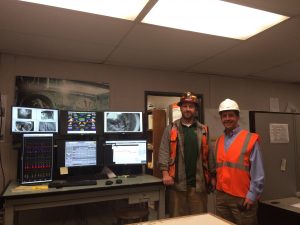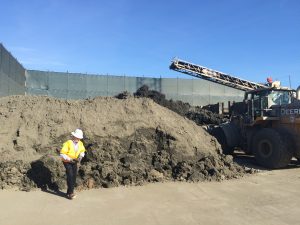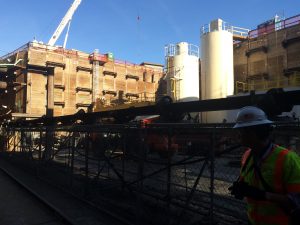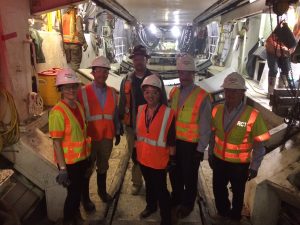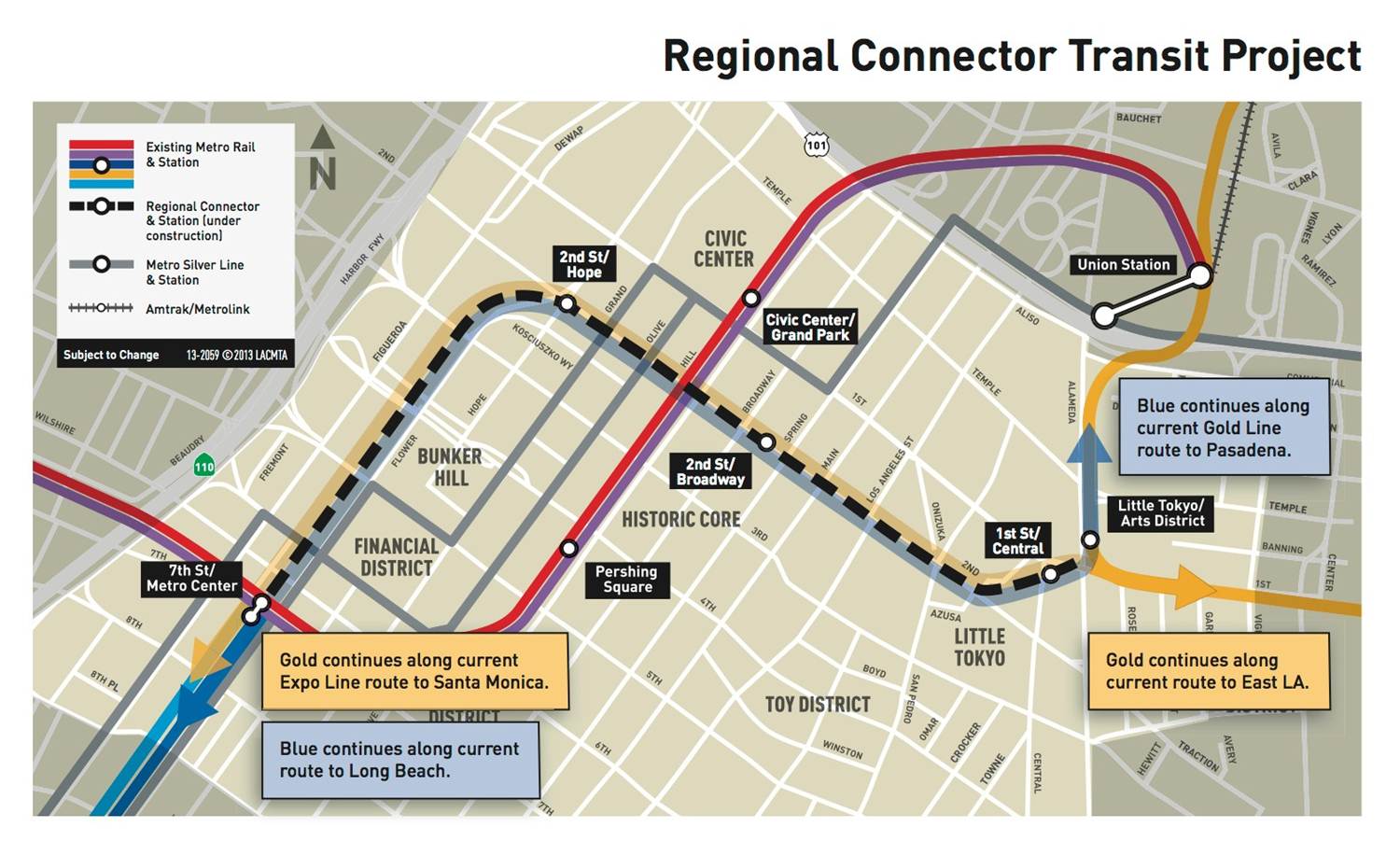
Map of the regional connector. Staging area was by the 1st and Central station on the right.
What’s a transit line without a tunnel? For densely populated areas, digging a tunnel can bring badly needed new capacity to congested corridors, while promising quick speeds underneath crowded roads. Plus tunnels represent interesting engineering and construction projects.
So when Jody Litvak of LA Metro invited me for a tour of the regional connector tunnel last spring, I jumped at the chance. At the time, the regional connector was under construction underneath Downtown Los Angeles, as you can see in the map above. I wrote about tunneling in Railtown, my book on the history of Metro Rail (I actually devoted a whole chapter to construction). But I’d never seen it up close until this tour.
I met Jody and her team at the staging area near Alameda and 1st Street in downtown. Olga Arroyo helped arrange the details, Dick McClane was the lead tunnel operator, and Bill Hansmire, Gary Baker and Glen Frank came along for the tour. Dick helps control the tunnel boring machine from a command center that resembles a miniature air traffic control tower. He monitors and corrects the machine’s every moment, using a complex network of sensors.
Dick also helps oversee the workers who do the tunneling. They call themselves “miners” — not “tunnel stiffs,” as the original tunnelers called themselves who built Metro Rail back in the 1980s, as I wrote in Railtown. The work is not for everyone: the miners described to me how some first-time workers have panic attacks when they get in the tunnel and simply can’t do the work.
But the regional connector and other train tunnels are actually a luxury — in the tunneling world. Many tunnels they work on are tiny and go miles deep, such as for sewers or other pipe infrastructure. The workers have to journey in the whole way on a makeshift train, leaning over to speed through the narrow tunnel. By comparison, this was a big, convenient tunnel. But still, there’s no daylight down there, so it’s a challenging work environment, and the miners work long shifts — sometimes 24 hours, 5 days straight on multiple shifts (with downtime in between, of course).
As the tour kicked off, safety was a priority. We were outfitted with helmets and reflective gear and instructed on proper procedures in the tunnel. Upon approach, the first thing we saw was the multi-block, fenced-off project site. The main feature was a conveyor belt from the shaft below, bringing up dirt that probably hadn’t seen the light of day in centuries, to be hauled off to help bury landfills. It created a huge pile that was actually just a couple days’ worth of excavation (see photo to the left).
The crew used this staging area to avoid disruption to the community from truck traffic coming out of tunnel. All that dirt requires a lot of vehicles to move it out of the area. In fact, truck traffic could be a limiting factor on tunnel boring, even if Elon Musk and his “Boring Machine” could speed the physical tunneling process.
Also visible up above were stacks of preset concrete slabs to line the tunnels, along with temporary steel rails. The rails help bring materials in and out of the tunnel, as they are hoisted down by crane and brought into the tunnel by temporary rail cars to lay more track.
We then journeyed down from the staging area to the giant shaft in the shape of the eventual station box. It had steep, temporary stairs leading down to the future station bottom and tunnel entrance. At the bottom, we could start walking through the actual tunnel.
Getting close to the tunnel, we could see lots of utility lines through pipes above us, including an old aqueduct from original the original Pueblo settlement. As the workers told me, these “station boxes” are where they find all the archaeological finds. Otherwise, the boring machine pretty much grinds everything else up (although evidently the formation that the tunnel passes through doesn’t typically have archaeological finds). For more on the archaeological finds in the tunnel, check out this article.
Inside the tunnel, it was hot with an odd smell. It was loud, too, particularly when workers dropped new 30-foot steel rails to the ground. The rails were needed for the temporary cars that brought in equipment. The tunnel boring machine (“TBM”) itself was probably about 100 yards long. In fact, it was so long, I was walking through it for a while without even knowing it.
The TBM is operated by four people: an operator, engineer, and mechanic, along with an MTA inspector. The machines have sensors everywhere and are extremely high-tech, monitoring the ground movement above. The software can automatically brake the TBM if the machine starts going in the wrong direction. The TBM uses pressure within the tunnel to maintain the pressure in the ground around the tunnel as it’s bored. That stabilization reduces, if not eliminates, both ground subsidence and gas seepage into the tunnel. For example, at the time of the tour, we were directly under a Japanese market in Little Tokyo. Hopefully, the patrons up above had no idea what was going on below. Sometimes TBM workers have to tunnel quickly through some parts of the city, like through certain soils that aren’t as solid.
Progress was steady: the miners were clearing about 80 feet in one day, at an average of 65 feet. They were starting with just the “left” bore for now, drilling it out for one mile, then hauling the tunnel boring machine (TBM) back to the project site and reassembling it for the “right” bore in the same direction, to create two tracks for the line. Overall, the first tunnel was set to take 5 months to go the whole 5,000 feet, 2 months to reassemble, and then another 5 months for the other tunnel.
In terms of cost, the tunneling represented only 10% of the total project cost. The station boxes are the other big chunk of change, particularly the future Bunker Hill stop, because it’s so deep.
Overall, it was an interesting opportunity to see digging in action. The project is scheduled to be finished in 2021. Once I ride it, I’ll end up whizzing through the section I walked. But I’ll now know how much work went into building it.
If you want more tunnel tour accounts, check out Curbed.LA from July and then again last month.

